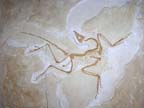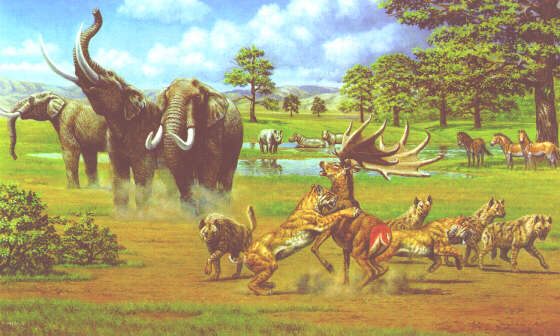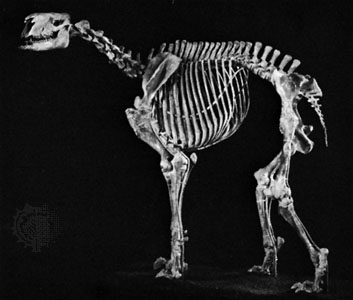 |
 |
 |
 |
 |
Produced
by the Population Genetics and Evolution class, Furman University |
||||
 |
 |
 |
 |
 |
Produced
by the Population Genetics and Evolution class, Furman University |
||||
 |
The
Neogene: Ungulate radiations of the Miocene |
 |
||
| Ungulata is
a paraphyletic grouping of hoofed mammals belonging to several orders,
including Artiodactyla (cloven-hoofed mammals such as sheep, goats, camels,
pigs, cows, deer, giraffes, and antelopes) and Perissodactyla (odd-toed
mammals such as horses, rhinoceroses, and tapirs; Speer 1995). Ungulates
experienced a great radiation during the Miocene when increased global
temperatures, large decreases in atmospheric CO2, and the drying of continental
interiors resulted in significant climate change. This climate change
in turn produced prolific ecological changes, such as the buildup of the
Antarctic polar cap, reduced mixing of tropical and polar waters, and
the emergence and subsequent expansion of C4 grasslands (Speer 2000).
This last change was crucial for the rapid radiation of ungulates, since
grasslands constitute one of their primary habitats. Researchers have
attributed this unprecedented growth of C4 grasslands to various factors,
including the aforementioned decrease in atmospheric CO2, a tectonically
related period of increased low-latitude dryness, and changes in seasonal
patterns of rainfall on a global scale (Pagani et al. 1999). Ungulates
adapted relatively quickly to life on these grasslands by evolving long
legs for greater running speed, digitigrade locomotion for quieter movement,
and complexly ground molar teeth to grind grasses (Speer 1995).
Page by Robert Mazgaj |
 |
| Moropus. Photo Credit: American Museum of Natural History, New York. | |
| Speer BR. 1995. Ungulates: Hoofed Mammals. University of California Museum of Paleontology. Accessed on April 19, 2010. Speer BR. 2000. The Miocene Epoch. University of California Museum of Paleontology. Accessed on April 19, 2010. Pagani M, Freeman KH, Arthur MA. 1999. Late Miocene atmospheric CO2 concentrations and the expansion of C4 grasses. Science 285: 876-879. |